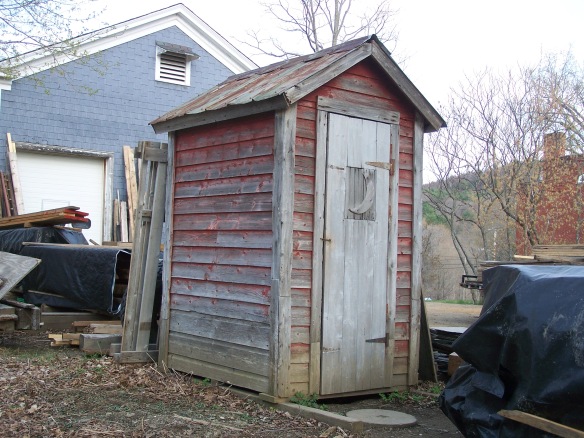
Vermont

Posted on 08/22/2020 12:45:42 PM PDT by nickcarraway
Public toilets around the globe have a reputation for being dark, dirty and dangerous. Tokyo recently unveiled new restrooms in two public parks that aim to address those concerns.
For one thing, they are brightly lit and colorful. Read more at https://www.todayonline.com/world/tokyo-now-has-transparent-public-toilets-let-us-explain
For another, they are transparent.
This way, the logic goes, those who need to go can check out the cleanliness and safety of the stalls without having to walk inside or touch a thing.
Japan has long experimented with toilets, resulting in lids that open and close automatically and seats that warm up. But the new stalls — designed by Shigeru Ban, the Pritzker Prize-winning architect — are made out of an opacity-changing “smart glass” that is already used in offices and other buildings to provide privacy when needed.
The toilets were installed in Japan’s capital this month, coinciding with a nationwide campaign to phase out the city’s old-fashioned public toilets ahead of the now-delayed Summer Olympics. Set up in front of a cluster of trees in the Shibuya district, the stalls stand out like a Mondrian painting, bearing tinted walls with colors like mango, watermelon, lime, violet and teal.
When occupied and locked properly, the tinted glass toilet stalls become frosted and opaque. When the door is unlocked, an electric current realigns the crystals in the glass to allow more light to pass through, creating a transparent effect. The toilets were presented as another futuristic and aesthetically pleasing example of the country’s technological advancements.
The reviews were mixed.
“I’m worried it will become transparent due to a malfunction,” a social media user with the Twitter handle @yukio wrote in a widely circulated post.
“It will take time to get used to the idea,” Ming Cheng, a London-based architect, wrote on Twitter. But he gave it a “thumbs up.”
Ms Serah Copperwhite, a technology worker based in a district south of Tokyo, said that while she normally avoided public toilets, she would be more inclined to use the new ones because they appeared bright and clean. “I trust the science,” Ms Copperwhite, 28, said in a phone interview Wednesday (Aug 19), addressing concerns on social media about the reliability of the glass technology.
Advocates have long called for the Japanese national government to make brick-and-mortar toilets in public spaces more appealing and accessible to residents and tourists. Some public bathrooms in Tokyo, particularly in train stations, lack hand soap. A kindergarten in southern Japan stopped taking children to a city park last year because they were deterred by the flies in the squat stalls. The school opted instead to use a park with Western-style flush toilets.
More than 300 restrooms were refurbished from 2017 to 2019, according to the Japan Tourism Agency. Before that, 40 per cent of the country’s public restrooms consisted of squat stalls rather than Western-style commodes. The government had sought to phase them out before the Olympics, which have been postponed because of the coronavirus pandemic.
But while some appreciated the new toilets’ advanced technology, some Tokyo residents said they were misplaced in exposed public spaces and were perhaps better suited elsewhere.
“I am not willing to risk my privacy because someone wants to make a fancy toilet,” Ms Sachiko Ishikawa, a 32-year-old writer and translator, said in a phone interview Wednesday from Tokyo.
Ms Ishikawa said she was concerned that human error would make it too easy for bathroom users to inadvertently expose themselves. The transparent structure could also make them more vulnerable to assailants, she said.
“They could be waiting for you if you’re getting out of the bathroom,” she said. “So the argument of protection does not hold for me.”
A predecessor to Tokyo’s transparent toilets appeared in Switzerland in 2002, when designer Olivier Rambert unveiled two glass bathrooms in the city of Lausanne. They had a controversial safety feature that automatically opened the doors and turned the glass transparent if sensors detected no motion for 10 minutes. That could conceivably help users who fall unconscious and need medical attention, he was quoted as saying.
In Japan, the Nippon Foundation plans to install toilets designed by other prominent architects at 17 locations by next year. But Ms Thalia Harris, a freelance writer who has lived in Tokyo for seven years, said she did not see the project as a practical solution to safety concerns.
“Personally, I think this will make people feel even more uncomfortable, especially for women,” Ms Harris, 29, said in a phone interview Tuesday.
She said she would continue to use the public bathrooms in Tokyo’s train stations, despite the lack of hand soap. She always brings her own, particularly because of the coronavirus outbreak.
“I would like them to address that before having these particular magic new toilets,” she said.

Vermont

Here’s a hint. .. Lookup Japan, rope seats, personal hygiene.... And a creek. .. That should get you started on your research. ...
“Trust me Taylor. ... You won’t like what you find there “ .Dr. Zayus.
For those worried about being “seen” I don’t think it’s a problem. The “natural” state of the plastic/glass material is probably opaque. When voltage is applied, the composition changes and it becomes translucent. When a person is inside and the door is locked, the voltage is off, so the glass is opaque, and the user is not visible. Upon unlocking the door and leaving, voltage is applied, and the interior becomes visible so the next person can see that it is vacant and available for use. Simple.
“It’s part of their national obsession with cleanliness.”
US cities, especially those overrun by vagrants (AKA “homeless”) should study what the Japanese do about the problem and follow their example.
“I’m worried it will become transparent due to a malfunction,”
At the worst possible time, like after a bad burrito dinner?
Looks like that dutch pisser, or whatever, dumps right into the canal?
*ouch*
The optimum material is polycarbonate: a specific gravity 40% of glass, indestructable, naturally translucent and dirt cheap; but can it be formulated to change opacity with electric current or other input. This requires American ingenuity.
Looks like Yoyogi Park... I think I know that spot.
The Chinese are catching up.

I live in a very rural appalachian area. Many of the older homes do not have septic tanks-raw sewage goes right into the creek behind the houses.
Down the creek you see people swimming every so often.
Most of these homes are old coal company company houses from the turn of the century.
I think that sums it up.
Lovely!
I didn’t notice that. Heh.

No way.
I raise you a two story outhouse;
https://www.atlasobscura.com/places/two-story-outhouse
I have been there.
That is cray-cray! :)
Disclaimer: Opinions posted on Free Republic are those of the individual posters and do not necessarily represent the opinion of Free Republic or its management. All materials posted herein are protected by copyright law and the exemption for fair use of copyrighted works.